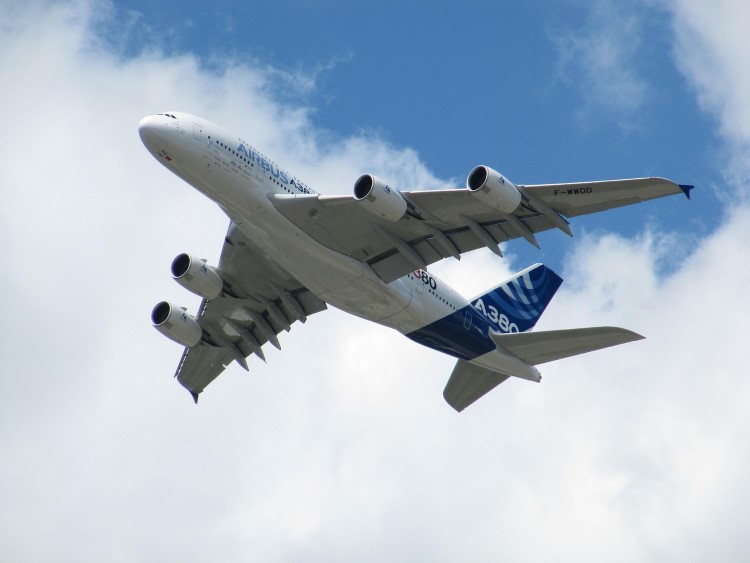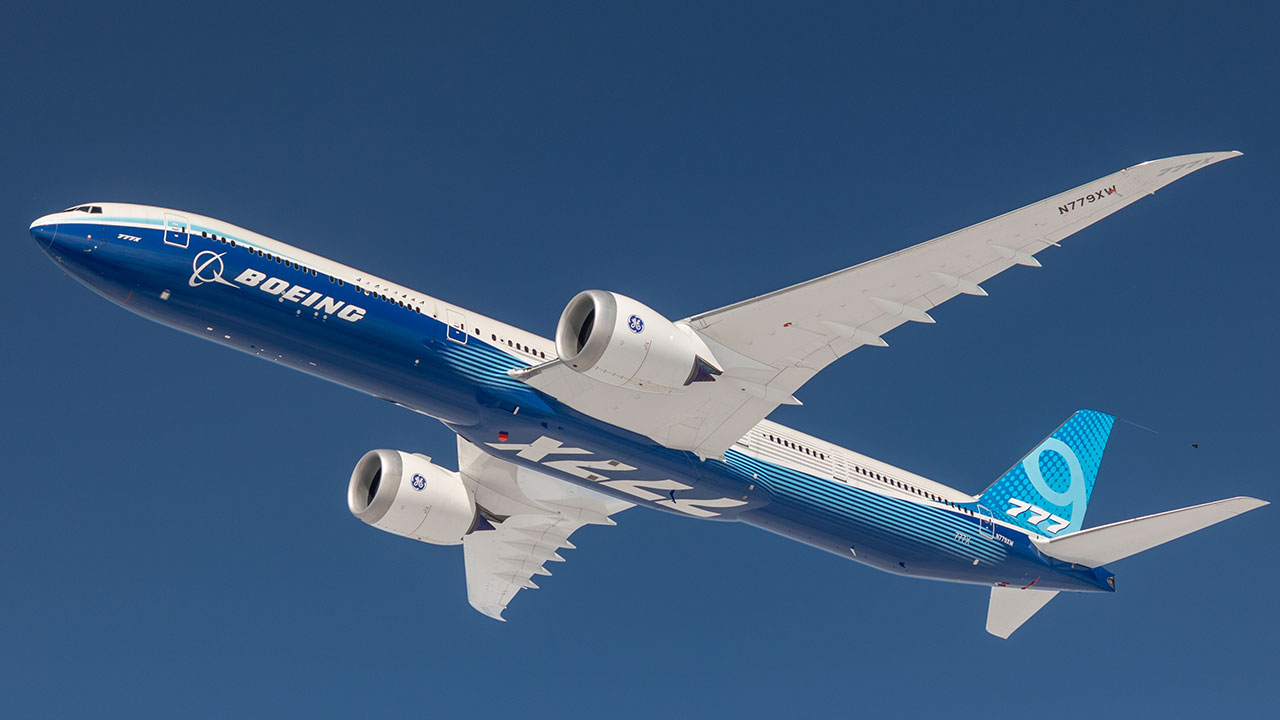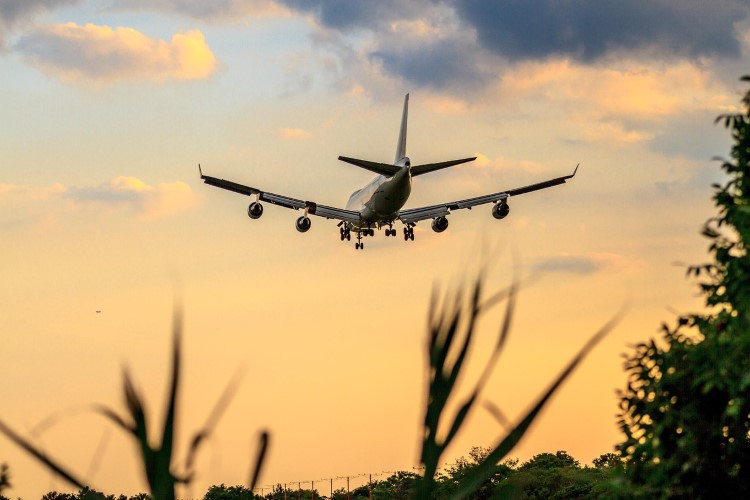Largest Private Jets Across the Globe
15 March 2025
| By Just Aviation TeamWelcome to Just Aviation, where we redefine the art of flying through our unwavering commitment to excellence and the epitome of luxury aviation. As a trailblazer in aviation services, Just Aviation takes you beyond the ordinary, offering an experience that is as exceptional as the aircraft that graces our fleet.
Private jets are the ultimate symbols of luxury, convenience, and exclusivity in the aviation industry. They provide unparalleled comfort, privacy, and flexibility for their owners and passengers, who can travel to any destination in the world without the hassle of commercial flights. But not all business private jets are created equal. Some are bigger, faster, and more extravagant than others. We will take a look at some of the top largest private jets in the world, based on their exterior length, passenger capacity, and market value.
1. Boeing Business Jet 747-8i : The Largest Private Jets
The Boeing Business Jet 747-8i combines long-range capability with advanced aerodynamics and cutting-edge avionics to enhance performance and operational efficiency:
- Dimensions: 76.3m wingspan, 76.4m length, 19.4m height.
- Range: 16,300 km (8,800 nmi) at Mach 0.86.
- Engines: Twin high-bypass turbofans (68,000 lbf thrust each).
- MTOW: 447,700 kg.
Advanced Systems
- Aerodynamics: Raked wingtips reduce induced drag by 8%, paired with chevron nozzles that lower noise footprint by 30% during takeoff. The redesigned empennage incorporates lightweight composites for improved yaw stability.
- Avionics: Dual HUDs (Head-Up Displays) with synthetic vision for low-visibility approaches. The flight management system (FMS) integrates predictive wind shear detection and 4D trajectory optimization.
- Structural Design: 50% composite materials (CFRP, GLARE) in wings and empennage reduce fatigue by 15% versus traditional aluminum.
Operational Considerations
- Payload-Range Flexibility: At 16,300 km range, the aircraft can operate nonstop on ultra-long-haul routes (e.g., New York-Hong Kong) with 50 passengers. For shorter sectors (e.g., Dubai-London), payload capacity increases to 90+ passengers.
- Runway Requirements: Requires 3,100m for MTOW takeoffs; wingtip clearance mandates 45m-wide taxiways.
- Crew Workflow: Dual electronic flight bags (EFBs) support real-time weather routing, while the 4-engine configuration simplifies ETOPS planning.

2. Airbus A380
The Airbus A380 has exceptional range, advanced avionics, and passenger comfort, making it a standout in the ultra-long-haul private jet market:
- Dimensions: 79.8m wingspan, 73m length, 24.1m height.
- Range: 15,200 km (8,200 nmi) at Mach 0.85.
- Engines: Quad turbofans (84,000 lbf thrust each).
- MTOW: 575,000 kg.
Advanced Systems
- Fly-by-Wire: Full digital flight controls with load alleviation logic, reducing wing stress by 12% in turbulence.
- Braking: Auto-brake-to-vacate (BTV) calculates optimal deceleration for rapid runway exits, minimizing ATC delays.
- Cabin Pressurization: 1,520 hPa cabin altitude at 12,000m cruise, paired with 25% humidity for passenger comfort.
Operational Considerations
- High-Altitude Performance: At Mexico City (2,300m elevation), thrust derating reduces takeoff performance by 18%, necessitating 3,800m+ runways.
- Parking Constraints: 79.8m wingspan requires dual jet bridges or remote stands with towbar-less tractors.
- Fuel Management: Center tank pumps prioritize fuel usage to maintain optimal center-of-gravity during climb.
3. Boeing 747-8 VIP
The Boeing 747-8 VIP redefines ultra-long-haul private operations with its unparalleled capacity for customization, payload flexibility, and technical sophistication. Its 4,786 sq ft cabin—the largest in the business aviation sector—is supported by a maximum takeoff weight (MTOW) of 987,000 lbs, enabling operators to prioritize either fuel (up to 54,000 lbs usable capacity) or payload.
The aircraft’s four GEnx-2B67 engines (66,500 lbf thrust each) incorporate advanced high-bypass ratios and composite fan blades, reducing fuel burn by 15% compared to legacy quad-engine jets. Aerodynamic enhancements, such as raked wingtips and a 10.6 ft wingspan extension, improve lift-to-drag ratios, enabling a cruise speed of Mach 0.855 and a service ceiling of FL430.
Transpolar Missions
The 747-8 VIP’s 8,000 NM range allows non-stop routing between hubs like London and Perth (7,825 NM), bypassing traditional fuel stops in Asia. Operators can leverage its 52,410-gallon fuel capacity to carry 12 passengers, 4,500 lbs of baggage, and still retain reserves for 90 minutes of holding.
- Cold-Weather Performance: At -50°C ambient temperatures (common at polar altitudes), engine anti-ice systems and robust APU redundancy ensure sustained operations. For example, a flight from Finland to Los Angeles can maintain cabin pressurization and thermal comfort even during extended holdover ice conditions.
Payload Prioritization
When configured with auxiliary fuel tanks, the jet can extend its range to 9,000 NM with a reduced passenger load (e.g., 8 passengers + 2,000 lbs cargo). Conversely, operators can maximize payload to 48,000 lbs (including fuel) for missions like government evacuations, integrating medical facilities or secure communication suites without exceeding structural limits.
- Runway Flexibility: Despite its size, the 747-8 VIP requires only 10,700 ft of runway at MTOW, enabling access to major hubs like Teterboro (TEB) with minor payload adjustments.

4. Airbus A340-300
The Airbus A340-300 VIP, a quad-engine workhorse, excels in missions demanding redundancy, cabin space, and hot/high performance. Its 2,126 sq ft cabin stretches 158 ft, accommodating up to 50 passengers in bespoke configurations. The aircraft’s four CFM56-5C4 engines (34,000 lbf thrust each) provide ETOPS-free routing, while its 197.8-ft wingspan and low wing loading (108 lbs/sq ft) enhance lift in thin-air environments. With an MTOW of 606,000 lbs and 45,600-gallon fuel capacity, it achieves a 7,100 NM range at Mach 0.82.
Oceanic & Remote Area Routing
The A340-300 VIP’s four engines permit direct overwater routes (e.g., Johannesburg to Buenos Aires, 3,900 NM over the South Atlantic) without ETOPS diversion constraints. Operators save 1.5 hours compared to twin-engine jets detouring via Dakar.
- Fuel Management: On a 12-hour flight, pilots can optimize fuel burn by cruising at FL370–FL390, balancing engine efficiency with cabin pressurization demands.
Hot/High Challenges
At Mexico City (MEX, elevation 7,349 ft), the A340-300 VIP can depart at 35°C with a 15,000 lbs payload (10 passengers + 2,000 lbs cargo), achieving a 2.8% climb gradient—critical for obstacle clearance in mountainous regions.
- Landing Gear Robustness: The aircraft’s 12-wheel main gear distributes weight efficiently, enabling operations on lower-grade runways like Marrakech (RAK) with minimal pavement reinforcement.
Cabin Modularity
Operators can partition the cabin into four soundproof zones (e.g., conference room, crew rest, VIP suite) while adhering to 22,000 lbs maximum floor load limits. For diplomatic missions, secure zones can integrate electromagnetic shielding without exceeding weight constraints.
5. Boeing Business Jet 787-8
The BBJ 787-8 merges cutting-edge technology with operational efficiency, leveraging a 50% composite airframe to achieve a 9,950 NM range at Mach 0.85. Its Trent 1000 or GEnx-1B engines (64,000–76,000 lbf thrust) reduce fuel consumption by 20% versus older widebodies, while the 2,400 sq ft cabin maintains 6,000 ft pressurization and 15% humidity at FL430. The aircraft’s 224,000 lbs MTOW supports diverse payload-range profiles.
Ultra-Long-Haul Efficiency
The 787-8 can fly non-stop from Geneva to Santiago (6,800 NM) with 18 passengers and full baggage, burning 18% less fuel than competing large-cabin jets. Composite materials eliminate corrosion inspections, reducing annual maintenance costs by 30%.
Short-Field Capability
At London City (LCY, 4,900 ft runway), the BBJ 787-8 can land with a 20,000 lbs payload (12 passengers + 1,500 lbs cargo) by leveraging its fly-by-wire brakes and 35° wing sweep for steep approaches.
Cabin Systems & Comfort
Electrical Architecture: Replacing hydraulic systems with electric compressors for doors and brakes cuts weight by 1,800 lbs and reduces failure points.
- Noise Mitigation: Chevron nozzles and active vibration dampers maintain cabin noise below 60 dB, critical for fatigue reduction on 16-hour flights.
Mission Flexibility
For airborne medical transport, the cabin can house ICU modules, leveraging the 220V power supply and 10,000 cubic ft/hr HEPA filtration.
6. Airbus A350 XWB
The Airbus A350 XWB (Extra Wide Body) redefines long-haul efficiency with its advanced aerodynamics, lightweight carbon-fiber-reinforced polymer (CFRP) airframe (53% composite), and optimized systems. Its 5,400 sq ft cabin provide the widest cross-section in its class (220 inches), enabling flexible configurations for 25–50 passengers.
Powered by two Rolls-Royce Trent XWB engines (97,000 lbf thrust each), the aircraft achieves a 9,700 NM range at Mach 0.85, with a maximum takeoff weight (MTOW) of 707,000 lbs. The A350’s 68.7-ft wingspan incorporates adaptive droop flaps and sharklet wingtips, reducing drag by 5%. Cabin pressurization at 6,000 ft and humidity levels up to 25% enhance passenger comfort on ultra-long flights.
Ultra-Long-Haul Efficiency
The A350 XWB can operate non-stop from New York to Singapore (8,285 NM) with 20 passengers and 3,500 lbs of baggage, leveraging its 49,400-gallon fuel capacity. Pilots can optimize step climbs from FL380 to FL430 to capitalize on reduced fuel burn at higher altitudes.
- Hot/High Performance: At Denver (DEN, elevation 5,430 ft), the aircraft can depart at 35°C with a 25,000 lbs payload, achieving a 2.5% climb gradient—critical for mountainous terrain.
Payload-Range Flexibility
Operators can prioritize cargo by configuring the lower deck with 4,500 lbs of bulk cargo, alongside VIP amenities. For example, a 14-hour flight from London to Santiago can accommodate 18 passengers, 2,000 lbs of luggage, and retain 1,200 NM reserves.
- Fuel Savings: The Trent XWB’s 10:1 bypass ratio reduces fuel consumption by 25% compared to older quad-engine VIP jets, saving ~8,000 gallons on a 7,000 NM mission.
Maintenance & Reliability
Composite structures eliminate corrosion inspections, while 10,000-hour engine service intervals minimize downtime. The aircraft’s Health Monitoring System predicts component failures, enabling just-in-time parts replacement.
- Airport Accessibility: Requires only 8,500 ft of runway at MTOW, allowing operations into airports like Aspen (ASE) with payload adjustments.
Strategic Use: Deploying for missions demanding premium comfort on 16+ hour flights (e.g., corporate shuttles between global hubs) or mixed passenger/cargo roles in remote regions.

7. Boeing Business Jet 777X
The BBJ 777X, based on the 777-8 airframe, combines the largest VIP cabin (3,256 sq ft) with groundbreaking efficiency. Its GE9X engines (110,000 lbf thrust each) and composite folding wingtips (235-ft wingspan folded to 212 ft) enable a 12,000 NM range at Mach 0.84. The cabin’s 6,000 ft pressurization and 20% humidity are maintained via a 100% fresh-air system. With an MTOW of 775,000 lbs, operators can balance 52,000 gallons of fuel with luxury amenities like spas or boardrooms.
Global Non-Stop Capability
The 777X can fly Sydney to Dallas (8,600 NM) with 30 passengers and 4,000 lbs of cargo, utilizing optimized cruise altitudes (FL410–FL430) to avoid headwinds.
- Folding Wingtip Advantage: At London City (LCY), wings fold to match a 767’s footprint, enabling access to slot-constrained airports without payload penalties.
High-Density Payloads
Configured for government transport, the cabin can seat 80 passengers in a 2-class layout while retaining 7,000 NM range. The 12,000 lbs cargo capacity supports secure diplomatic pouches or medical equipment.
Systems Redundancy
Triple-redundant hydraulic systems and four APUs ensure operational continuity during extended remote operations (e.g., Antarctic logistics support).
- Fuel Efficiency: The GE9X’s 27:1 bypass ratio cuts fuel burn by 12% vs. the 747-8, saving ~10,000 gallons on trans-Pacific routes.
8. Boeing Business Jet 767
The Boeing Business Jet 767, a proven widebody, balances range (7,500 NM) with operational versatility. Its 2,800 sq ft cabin (154 ft long) and 451,000 lbs MTOW support diverse configurations. Powered by two Pratt & Whitney PW4062 engines (63,300 lbf thrust each), it achieves Mach 0.80 cruise with 26,500-gallon fuel capacity. The aircraft’s 156-ft wingspan and robust landing gear enable operations from semi-prepared runways.
Gradual Climb Performance
From Quito (UIO, elevation 9,350 ft), the aircraft can depart at 30°C with 18,000 lbs payload, maintaining a 2.2% climb gradient over the Andes.
Modular Cabin Flexibility
Operators can partition the cabin into six zones, including a 40-ft conference room and crew rest area, while adhering to 18,000 lbs floor load limits.
- Cargo Hybrid Missions: The lower deck accommodates 3,800 lbs of palletized cargo, ideal for NGO (Non-Governmental Organizations) supply runs to remote African airstrips.
Cost-Effective Maintenance
6,000-hour engine overhauls and aluminum airframe simplicity reduce lifecycle costs by 40% compared to newer composite jets.
- Proven Reliability: The 767’s mechanical flight controls (vs. fly-by-wire) simplify troubleshooting in regions with limited technical support.
FAQs
What are the largest private jets available today?
The largest private jets include models like the Bombardier Global 7500, Boeing Business Jet, and Gulfstream G650. These aircraft offer spacious cabins and advanced avionics, making them ideal for business aviation.
Which private jet has the largest cabin space?
The Bombardier Global 7500 boasts the largest cabin space among private jets, providing ample room for passengers to travel comfortably on long-range flights.
What is the fastest business jet in the world?
The fastest business jet currently is the Gulfstream G700, which can reach top speeds of Mach 0.925, making it one of the most advanced jets in the aviation market.
What distinguishes ultra-long-range jets from other private jets?
Ultra-long-range jets, such as the Bombardier Global 8000 and Gulfstream G650ER, are designed for non-stop flights over long distances, offering exceptional cabin altitude and comfort for passengers.
What is the typical passenger capacity of large private jets?
Large private jets like the Boeing 747-8 VIP can accommodate up to 20 or more passengers, depending on the interior configuration and cabin design.
How does the cabin of a private jet compare to that of a commercial aircraft?
The cabin of a private jet is typically more spacious and luxurious compared to commercial aircraft, with customizable interiors and amenities tailored to the preferences of private owners.
When can we expect new models of private jets to be released?
Several new business jets are expected to hit the market between 2022 and 2025, including advanced models from manufacturers like Bombardier, Gulfstream, and Dassault.
What are the benefits of owning a private aircraft?
Owning a private aircraft provides flexibility in travel, access to more airports, and a personalized flying experience, making it a preferred choice for corporate jet owners and high-net-worth individuals.
Just Aviation’s partnership with the is a symphony of business private jet luxury innovation. From its advanced avionics to its meticulously designed cabin, every element is orchestrated to perfection. Our dedication to providing you with a seamless, comfortable, and unforgettable journey is evident in every aspect of the aircraft.
